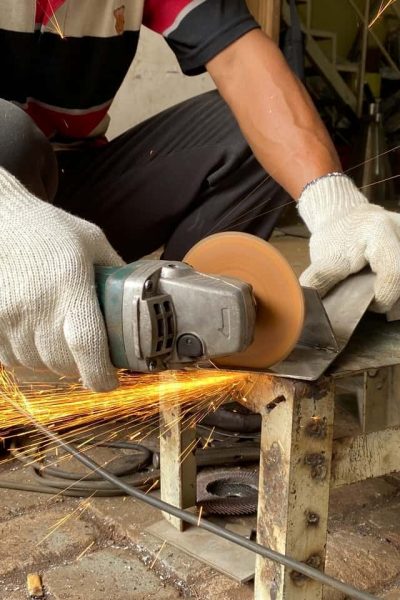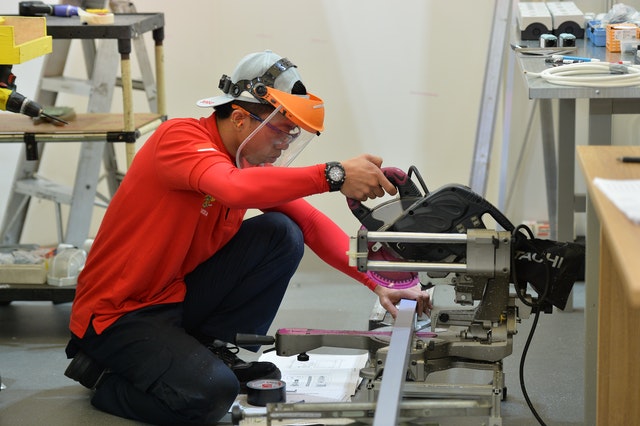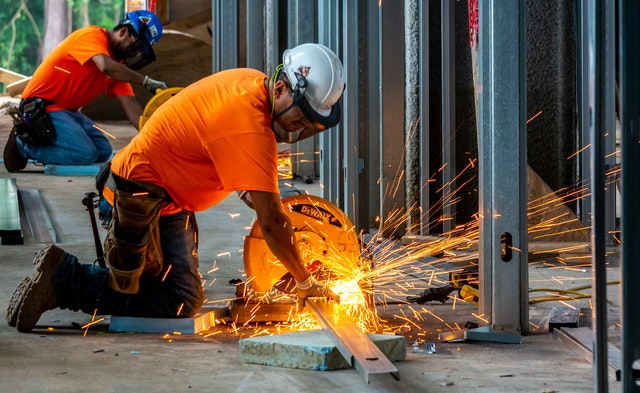
10 Ways for Cutting Stainless Steel Like a Pro
According to the SSINA, stainless steel isn’t a single alloy but an umbrella term encompassing a group of iron-based alloys containing at least 10.5% chromium. Other elements, including chromium, increase corrosion resistance, improve heat resistance, enhance mechanical properties, and provide this metal with incredible strength.
It is corrosion-resistant and has a variety of uses in the manufacturing industry. Further, it can be classified into different grades. The grade of stainless steel depends on its strength, resistance to corrosion, and ability to withstand heat.
Stainless steel provides a wide range of applications starting with sheet metal, jewelry, cars, bridges, or sculptures. It is a hard metal and can be used to coat softer metals. But none of these would have been possible without the cutting process.
There are many different types of steel cutting techniques and each has its own advantages and disadvantages. The most common types are sheet cutting, tube cutting, panel and pipe cutting, and finally wire cutting. Fortunately, you can rely on many tools and methods to cut stainless steel safely and efficiently. This article explains the best DIY stainless steel cutting techniques and tools, including an angle grinder, plasma cutter, Dremel, and other highly-efficient methods to cut stainless steel like a pro.
Follow the lines below and learn how to cut stainless steel with 10 different tools and techniques.
Using Angle Grinder for Cutting Stainless Steel
An angle grinder is a handheld tool used for abrasive cutting, and it’s ideal for cutting stainless steel plates. It has a wide variety of uses and can be used to cut, grind, sand, polish, and buff. It has two handles that are connected to the head by a shaft that rotates in the opposite direction of the head. The handles can be adjusted to change the position of the head. They are connected by gears that allow for more control over speed and torque as well as less strain on the user’s wrists. The blades are made from tungsten carbide or diamond, so they last longer than traditional metal blades. The blades can be changed depending on what job needs to be done. There are many benefits to using an angle grinder on stainless steel. First is that you do not need any cutting fluid, and second is that it can cut through thick pieces of metal, which is not possible with other tools like hacksaws or saws.
You can use an angle grinder cut-off wheel that’s about 5 inches, which is suitable for this operation. Use safety gear during the process.
Step #1
Balance the grinder appropriately while securing the disc precisely in the center of the device. When a grinder is not entirely stable, it may cause the wheel to damage or even break.
Step #2
After setting the grinder and cut-off wheel, highlight a place you want to cut using a marker.
Step #3
Set the device on top of the material and align the disc with the area you need to cut.
Step #4
Slowly lower the wheel down to the steel plate. Use some effort to push the disc all along the line. Allow the disc to cut through the steel panel all the way and get the desired cut.

Using Dremel
Dremel is a powerful hand-held rotary tool that is used for cutting, grinding, polishing, sanding, and engraving. It is a versatile tool that can be used for a variety of purposes not only by professionals but also by DIY enthusiasts. While it is predominately known as a tool to use in the construction industry, it can also be used as an alternative to saws and blades. It can be used to cut through tough materials like metal, tile, and glass with its built-in small cutting wheel.
Many factors determine the ideal rotational speed for cutting objects with a Dremel. The RPMs of your model, the material type, and the thickness of the material are just a few factors. A rotational speed of 5000 rpm is the ideal speed for cutting stainless steel with a Dremel.
Since Dremel is similar to an angle grinder, the cutting process is more or less the same.
Using Chop Saw
A chop saw is a small handheld tool suitable for cutting through thinner pieces of stainless steel. It is preferable to use the pneumatic cut-off saw due to the added power through the air pressure. It is crucial to choose the blade adequate for this process. The blade is usually driven by an electric motor that rotates the blade at high speeds. The blade is usually mounted on a vertical arm that has a pivot point in the middle and is connected to the power source. The arm can be moved up and down to control the depth of the cut. Many different types of blades can be used with a chop saw, including carbide tipped blades, tungsten carbide tipped blades, high-speed steel blades and others.
When working with this device, it’s necessary to use a full-face shield because the small pieces of steel can fly around.
Step #1
Mark the place where you are going to cut and slowly lower the blade onto the material.
Step #2
Cut through the steel material slowly, without pause.
Step #3
Clean a grinder with the small polishing wheel to remove the remaining and polish the edges.
Using Circular Saw
A circular saw is a handheld power saw that has a circular blade. If you use a proper blade type, this tool can quickly cut through stainless steel.
Circular saw blades for cutting stainless steel can be found in three types:
- TCT Saw Blades are the most common type. They are made from tungsten carbide and have teeth all around the edge of the blade.
- HSS Saw Blades use high-speed steel to create teeth around the edge of the blade.
- Carbide Saw Blades are made from tungsten carbide and have teeth on one side only.

Step #1
Set up a metal cutting blade made explicitly for stronger steel, set the plywood-based board for a strong backing, and mark the cutting place.
Step #2
Cut slowly into the steel and keep the blade in motion.
Using Jigsaw to Cut Stainless Steel
Jigsaw is a small handheld device made for performing difficult cuts such as curves. It functions by pushing the blade through the material and then pulling it back out again, rather than pushing it all the way through like with a saw. This allows for more control over where the cut will be made. It is handier than a circular saw when you need tight curves and interior cutouts.
A jigsaw with a carbide blade can cut steel sheets up to 5/64-inch thick, allowing you to make long and straight cuts.
Step #1
A jigsaw needs a starter hole, which you can drill with a regular drill or a hole saw for metal.
Step #2
Place the sheet on your work surface and mark the cutting line with a marker on the sheet’s backside.
Step #3
Place a straight edge over the stainless sheet.
Step #4
Apply steady but modest pressure on the saw, allowing the blade to do the work. However, do not force the saw to avoid metal overheat and dulling the edge.
Step #5
Clean up the cut edge to remove burrs. You may use a metal file or 80-grit sandpaper and a sanding block to do it.
Using Band Saw
Stainless steel cutting band saw has been used for cutoff works on the pipe. It cuts the steel on a horizontal surface by lowering the blade down through the metal.
Its edge for stainless steel has a similar tooth template as a jigsaw blade. If you need a smooth cut, set the speed option at a low level.
Step #1
The cutting action is done on a horizontal surface by lowering the blade through the metal.
Step #2
For smoother cut, set the speed option at the lower level.
Using Hacksaw
A hacksaw is a fine-toothed saw primarily designed for cutting metal and stainless steel cable. For hacksaw cutting, you need the vise and a piece of wood about 3x3x6 inches.
Step #1
Drill the hole at 8/34 inches through one of the shorter dimensions, about 1 inch from the end.
Step #2
Tighten up a wooden block in the clamp with a hole parallel to a wall and provide enough space to stretch out the cable.
Step #3
Next, use a carbide rod hacksaw and perform a 90° cut on the hole. The hole in the wooden block holds both sides of the cables securely so that they couldn’t move and jag, while the cuts guide the hacksaw to finish the process.
Using Drill
Drilling stainless steel is considered a complicated activity, mainly because it can be time-consuming. However, it is one of the biggest misconceptions when it comes to cutting stainless steel.
Since stainless steel is a relatively soft material (at least in its initial state), the overall drilling process doesn’t have to be that painful.
Step #1
Apply a lot of pressure on the drill bit. Smaller bits may not be convenient since the pressure can make them bend and break.
Step #2
Ensure the continuous spiral of the material comes off the bit as it turns.
Step #3
It is essential to keep the drill and stainless steel cool. That said, make sure you regularly stop drilling and drip some oil onto the hole. You can use olive oil or cutting oil. Still, it is crucial to stop drilling from time to time and ensure there is plenty of oil.
Make sure you’re wearing safety glasses during the process.
Using Tube Cutter
A tube cutter is a tool plumbers use to cut pipes. Still, there is a tube cutter specifically designed to cut stainless steel, and it is recommended to use it.
Step #1
Mark the surface you want to cut with the disc on the cutter.
Step #2
When the tube is set up, fix it into place by rotating the knob. Carry on turning the knob until the tube is secure.
Step #3
Hold the exposed end in one hand and rotate the tube cutter with another hand. While you rotate the tube cutter around the tube, the small cutter wheel will progressively cut through the pipe.
Step #4
Finally, the disc will cut all along the line through the tube, and the piece of tubing you cut will fall off.

Using Plasma Cutter
A plasma cutter is ideal for cutting large and hard stainless-steel panels. It uses the concentrated energy beam to cut through a pretty thick piece of material without much issue.
Step #1
Begin with the operation by placing the cutting end about 3 inches away from the surface of the metal and run the cutter. It will burn through the steel panel immediately, allowing you to cut along the line.
Step #2
For the best results, you must be cautious and hold a steady hand to perform a straight cut.
Safety Measures while Cutting Steel
It is vital to ensure your working environment is 100% safe when cutting stainless steel. When you work with cutting tools, a fall can cause a severe accident. So, be cautious and secure your working area.
Here are some tips on how to make your work environment safe:
- Prepare your workspace – Move the toolboxes, scattered tools, steel plates, materials, power cable on the one side of the working space because all this stuff can cause a trip or fall that can be fatal.
- Light up your work area properly – Adequate illumination with background lightning and floodlight allows you to see without straining your eyes. This is essential when using goggles which can blur your vision if they become dusty or foggy.
- Secure power cables – Put power cables behind you to prevent tripping or to cut yourself.
- Ensure proper ventilation – Cutting and grinding will cause metal scraps, waste, and dust. Therefore, keep your door and window open.
- Prevent fire hazard – Remove gasoline, gas cylinders, diesel, paper, and all flammable materials from your workspace.
- Remove jewelry, earphones, and scarves – Remove any jewelry, bracelet, or scarves. Take off the earphones. All of this can cause an accident. So, be careful.
- Get a fire extinguisher – Get a fire extinguisher adequate for A, B, C, D, and K fires.
- Be aware of your surroundings – Keep children out of your workspace.
Besides protecting your workspace, it’s necessary to protect yourself adequately. That’s why you must use personal protective equipment to protect your eyes, lungs, hands, and feet from injury.
These are some tips on how to protect yourself:
- Eye Protection – Certified goggles are required to protect your eyes from flying particles and sparks. Also, you need a full-face shield that delivers additional protection.
- Hand Protection – Gloves are ideal for protecting your hands from sparks or small fragments of waste metal thrown out during the cutting process.
- Breathing Care – Use a proper dust mask to protect yourself against dust and fume particles. Make sure you seal it adequately around the face. If tiny dust particles pass into your lungs during an extended period, it can cause lung disorders or cancer.
- Foot Protection – Safety shoes with steel insoles are required, especially If you’re dealing with large items.



